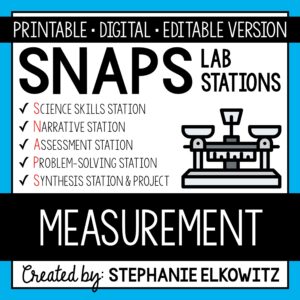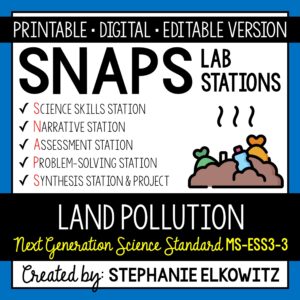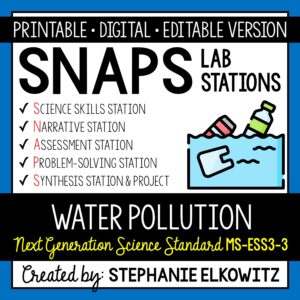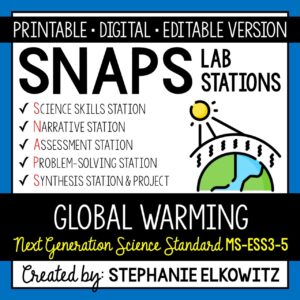MS-LS1-5 Environmental Influence on Plant Growth Lab
$7.00
An engaging lab activity designed to enhance students’ understanding of environmental and genetic influences on plant growth. Aligned with NGSS MS-LS1-5.
Description
MS-LS1-5 Environmental Influence on Plant Growth Lab Preview
SNAPs Lab Stations Activities require students to use science, math, literacy, problem-solving and engineering skills. They are designed to enhance students’ understanding of scientific concepts and help students apply scientific ideas to the real world. Each station activity promotes skills so to develop students into proficient and competent scientific thinkers.
SNAPs lab activities have five components:
• Science Skills Station to develop science skill proficiency
• Narrative Station to build science literacy
• Assessment Station to evaluate learning and understanding
• Problem-Solving Station to foster engineering design
• Synthesis Station and Project to inspire higher-order learning
DIGITAL LABORATORY – DISTANCE LEARNING & DIGITAL CLASSROOMS
• This lab is offered in a digital format to support digital classrooms & distance learning.
• The digital lab activity is designed to work with Google Slides and Microsoft PowerPoint
• The digital lab activity CANNOT be edited. However:
– Students can manipulate text boxes
– Students can create tables, graphs and diagrams
– Students can insert images and drawings
GOOGLE FORM ASSESSMENT STATION
• The assessment station is offered as a self-grading Google Form.
• Questions are all short answer and are 100% editable.
• Suggestions for use are included in the download.
DISTANCE LEARNING COMPATIBILITY
SNAPs lab activities are rated for their ease with distance – independent learning. Refer to the preview for more information about how well this laboratory works in a fully digital classroom and with distance learning.
EDITABLE DOCUMENTS
This download includes an editable word document (docx file) of all lab components:
• Pre-Lab and Post-Lab Activities
• The Lab Overview
• Lab Station Activities and Questions
• Directed Synthesis Project (when applicable)
Important Notes:
• Diagrams, illustrations, tables and graphs essential to lab activities are included
• Illustrative clipart is NOT included
• Editable documents and rubrics are included with the FREE SNAPs Setup Guide
Editable files allow you to:
• Edit the scope of the activities so to suit your students’ needs
• Edit the materials required based on resource availability
• Create single-period “mini-labs” using activities at the individual skills stations
The activities at each station in this lab are detailed below.
Environmental Influence on Plant Growth Lab Learning Objectives
1. Analyze and interpret data that suggests environmental and genetic factors impact plant growth.
2. Identify environmental factors that impact plant growth.
3. Compare and contrast the influence of environmental and genetic factors on plant growth.
4. Discuss how plants respond to changes in light availability, water availability and temperature.
5. Manipulate genetic and environmental factors so to optimize the growth of an herb.
Science Skills Station
Students will graph, analyze and interpret data to determine the impact of fertilizer on plant growth. Specifically, students will study how fertilizer impacts different measures of plant growth (plant height, size of leaves, number of flowers, etc.)
Narrative Station
Students will read an informational text about environmental and genetic factors that impact plant growth. Students will also read about how the plant growth changes in response to variations in temperature, water availability and light availability.
Assessment Station
At this station, students will answer questions about key terms and ideas relating to factors that influence plant growth and how plants respond to certain environmental changes. Students must employ lower, mid and higher order thinking skills to answer these questions.
Problem-Solving Station
Students will design a “system” that optimizes the growth of a common herb. Students design their setup so to maximize plant growth in the shortest amount of time. Students will consider environmental and genetic factors in the setup of their plants.
Synthesis Station
Students will compose a CER (claim-evidence-reasoning) report to summarize the lab. Students are provided the claim statement and must support the claim with observations, data and other information gathered in the lab. Students will explain how the evidence supports the claim using scientific reasoning.
Synthesis Project
Students will have a choice of 11 projects. Refer to the SNAPs Lab Stations Best Practices and Setup Guide for directions and suggestions on how to conduct the project.
Directed Synthesis Project
Students can conduct one of the 11 standard synthesis projects, but I strongly suggest using the directed synthesis project to best summarize the information in this lab. In the directed project, students will test the designs they constructed at the problem-solving station. Students will make observations of the plant over a five-week period. They will compare their results to the results of other lab groups. From this, students will evaluate their design and propose improvements so to enhance the growth of their plants.
This download includes:
• A pre-lab assignment and post-lab reflection
• Directions and questions for each lab station
• Student recording sheets
• Teacher Key
Additional Materials Required:
Ruler
Colored Pencils (optional)
5 packages herb seeds (different varieties)
Plastic cups (2-3 different sizes)
Styrofoam cups (2-3 different sizes)
Paper cups (2-3 different sizes)
1 bag of topsoil (basic, no fertilizer added)
All Purpose Plant Food (no more than 3 lbs)
Scale
Graduated cylinder OR teaspoon and tablespoon measuring device
Small containers (one for each herb)
Large container (such as a 56qt storage tote)
Plastic spoons (1 per seed variety)
Small shovel or similar tool (for soil)
LINKS TO VIDEOS
This laboratory requires internet to access videos. Videos are hosted on SafeShare.TV so to safely watch and share educational YouTube videos without ads, comments and other distractions. Full and shortened links to original YouTube videos are included.
NEXT GENERATION SCIENCE STANDARDS
This laboratory satisfies NGSS MS-LS1-5. It combines the three dimensions of science learning – science and engineering practices, disciplinary core ideas and crosscutting concepts – to meet the standard. This lab also makes interdisciplinary connections to STEM, Math CCSS and ELA CCSS to build the appropriate skills.
TERMS OF USE
• All rights reserved by Stephanie Elkowitz.
• This product is to be used by the original purchaser only.
• Intended for classroom and personal use only.
• Copying for more than one teacher, classroom, department, school, or school system is prohibited.
• This product may not be distributed or displayed digitally for public view.
• Failure to comply is a copyright infringement and a violation of the Digital Millennium Copyright Act (DMCA).








